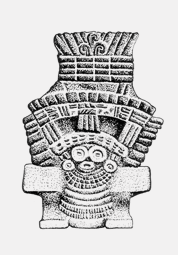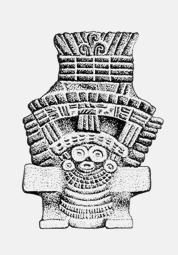The Lords of the Butterfly Bird God: a new group of the Teotihuacan elite
Los Señores del Dios Mariposa Pájaro: un nuevo grupo de la élite Teotihuacana
This article first discusses who is mortal and who is immortal in Teotihuacan art, then identifies a type of high-ranking character whose iconography suggests they were part of a group that was under the protection of the Butterfly Bird God. These are called Lords of the Butterfly Bird God because that is how we see them in different contexts, in life bearing insignia of the elite, and in death in the form of mortuary bundles. These figures also appear with headdresses bearing images of the Butterfly Bird God’s temple. The text then evaluates whether an exceptional set of ceramic figurines from Tlajinga district, Teotihuacan, represents an elite group led by the Lords with Butterfly headdress.
Keywords: Teotihuacan iconography, myth of the Butterfly Bird God, mortuary bundle, figurines.
INTRODUCCIÓN
This paper examines the iconography of the Teotihuacan elite. Teotihuacan (100 bc-600/650 ad) was the seat of the hegemonic Mesoamerican state in the Early Classical period (200-600 ad). At its height, the city extended 20 km2 and had a population of about 100.000 inhabitants (fig. 1a-b). The monumentality of its ceremonial architecture, centered on a triad of pyramids –of the Sun, the Moon and the Feathered Serpent– is unparalleled in the history of Mesoamerica. Also unique is its strictly orthogonal urban plan, laid out like a chessboard consisting of multi-family residential compounds. What were the Teotihuacan state and its elite like? Despite its pan-Mesoamerican importance, we know little about it. Archaeologists have long debated whether it had a powerful monarch or some form of collective government (see Carballo 2020). Iconographic investigations offer some proposals but identifying the ruler and lower-ranking lords of the elite in Teotihuacan art is no easy task. Manzanilla (2009) has argued that the rulers correspond to the four characters depicted on the renowned Las Colinas vessel, while Headrick (2007) states that the ruler would have been identical to the high-ranking figure represented in a mural at Atetelco, Teotihuacan. For my part, I have argued that the highest-ranking group in this city wore Tasselled Headdresses as their insignia and that their leaders –who wore the Great Tasselled Headdresses of the Rain God– were also the rulers of Teotihuacan (Paulinyi 2001). In this article I will address a new group of lords whose existence I noted when studying images from the iconographic complex of another member of the Teotihuacan pantheon: the Butterfly Bird God, an important sun deity, linked to plant fertility (Paulinyi 1995, 2014) (figs. 2a-c). I also proposed the existence of a myth about this god’s descent to the underworld and subsequent rebirth. The aim of this article is to identify the lords who were under his protection.

Figure 1. Images of Teotihuacan: a) view from the Moon Pyramid (photograph by Zoltán Paulinyi); b) plan of the civic-ceremonial center of the city (Millon 1973: map 1, detail). Figura 1. Imágenes de Teotihuacan: a) vista desde la Pirámide de la Luna (fotografía de Zoltán Paulinyi); b) plano del centro cívico-ceremonial de la ciudad (Millon 1973: mapa 1, detalle).

Figure 2. Images of the Butterfly Bird God: a) scattering gifts with both hands (Séjourné 1966b: fig. 38, detail); b) with anthropomorphic head, butterfly wings and, instead of a torso, an emblem bearing Reptile’s Eye glyph (Séjourné 1966b: fig. 94); c) in the “Glyphs” mural in the Palace of the Sun, Teotihuacan (Langley 1993: fig. 8). Figura 2. Imágenes del Dios Mariposa Pájaro: a) esparciendo regalos con ambas manos (Séjourné 1966b: fig. 38, detalle); b) con cabeza antropomorfa, alas de mariposa y, en vez del torso, un emblema con el glifo Ojo de Reptil (Séjourné 1966b: fig. 94); c) en el mural de los “Glifos” del Palacio del Sol, Teotihuacan (Langley 1993: fig. 8).
MORTAL VERSUS SUPERNATURAL
How can we distinguish representations of the Butterfly Bird God from those of his lords? Representations of this god –appearing principally on painted vessels (Conides 2017, 2018)– tend to present variable bodies: either an anthropomorphic figure dressed as a butterfly and/or bird (fig. 2a), or a compound figure with anthropomorphic head, butterfly wings, sometimes one or two hands, and frequently a circular or semicircular emblem as a torso. This emblem usually bears the “Reptile’s Eye” (re) glyph, probably the calendar name of the god (Paulinyi 2021) (figs. 2b-c, 3). Likewise, the images of this deity may appear accompanied by a bird, a butterfly, or a hybrid butterfly-bird creature (e.g., Conides 2018: figs. 5.3, 5.4; Séjourné 1966b: figs. 38, 130).
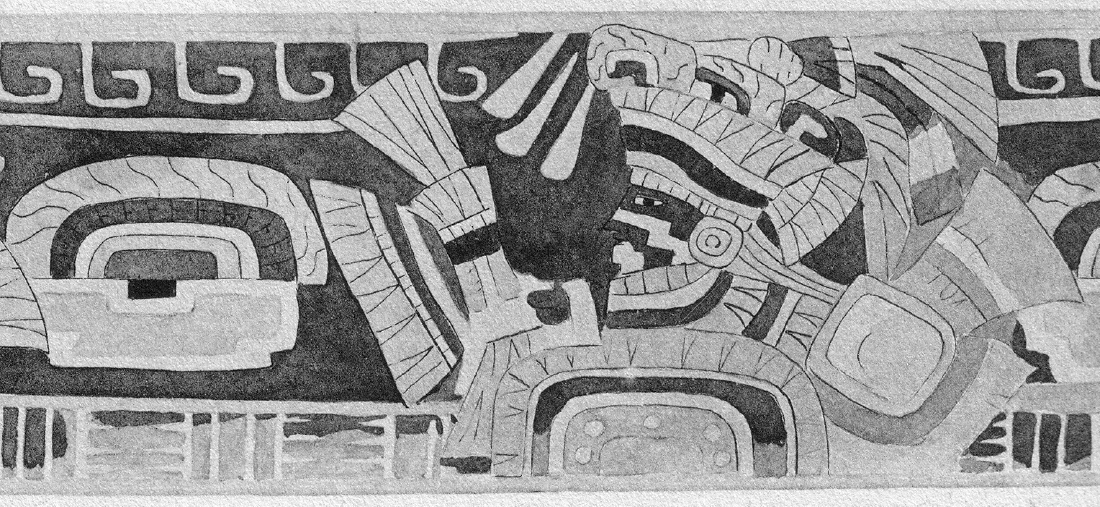
Figure 3. Lord with Butterfly Headdress holding feathered bundle and shield. Teotihuacan vessel from Kaminaljuyu (Kidder et al. 1946: figs. 174 D and d´). Figura 3. Señor con Tocado de Mariposa sosteniendo un atado y un escudo emplumados. Vasija teotihuacana de Kaminaljuyu (Kidder et al. 1946: figs. 174 D y d´).
Conides (2017, 2018: 107-124) considers that all these images represent mortal persons, members of an institution dedicated to the cult of a butterfly deity whose identity is vague (she only recognizes butterfly persons, although these may frequently also contain a bird component). On the other hand, Headrick (2007: 130) and Taube (2002 [2000]: 301-309), among others, believes that they could be butterfly warriors. However, there are substantial arguments to the contrary, which claim that they are not mortals but represent a deity. In these individuals, both the butterfly body and the symbolic body mentioned above (see Conides 2018: figs. 3.7, 6.27, 6.28) suggest that they are not images of mortals, but of a supernatural being; and that the anthropomorphic version of this person is likewise supernatural, as it shares the same iconography. This proposition is also supported by the fact that these figures act in ways that would be impossible for mortals but normal for supernatural beings, such as descending to the underworld (de la Fuente 2006a [1995]: pl. 7, figs. 6.2 and 6.4; Séjourné 1966a: fig. 130; Paulinyi 2014: 34-39) or being reborn from a broken squash (Conides 2018: fig. 6.40; Evans 2010: fig. 8; Paulinyi 1995: fig. 12c), as well as rising from portals of the underworld (fig. 2c) (Conides 2018: figs. 4.3a-c; Berrin & Pasztory 1993: fig. 158; Evans 2010: fig. 8; Taube 2006: fig. 7b).
OOOOIn my opinion, a criterion exists for distinguishing between gods and mortals represented in Teotihuacan art (Paulinyi 2014: 30-31). The most important mortal archetype in Teotihuacan art is that of a person making an offering to the gods; he is holding a ritual bag or other type of container in one hand, while with the other sprinkles liquid or scatters small objects (e.g., Miller 1973: figs. 171a-177, 235 and 366). The bag is emblematic of a person making an offering. In contrast, deities like the Rain God (Séjourné 1966c: pl. 92), the figure that is likely the Water Goddess, depicted on the murals of Tetitla and Tepantitla, Teotihuacan (Miller 1973: figs. 301-314; Paulinyi 2007), and other supernatural beings (Miller 1973: 124, 231) are not seen making offerings, but delivering their gifts to mortals –scattering them with both hands, without using a bag, or with one hand if they are represented with only one (Miller 1973: figs. 201-203). There is one exception which in fact supports the general rule; this is the representation of the Rain God of Zacuala, Teotihuacan, who carries a bag and a maize plant (Miller 1973: figs. 206-208). When we ask whether the butterfly bird figures described here are representations of the Butterfly Bird God or of mortals, the argument is that they scatter their gifts like deities, i.e. with one or two hands (fig. 2a) (see Conides 2018: figs. 5.2, 5.3, 6.25, 6.27; de la Fuente 2006a [1995]: fig. 6.4; Paulinyi 2014: fig. 2; Séjourné 1966b: fig. 130b). They do not make offerings, they do not use the ritual bag used by mortals. This firmly supports the proposal that these figures represent the god, not mortals.
OOOOSo far, we have analyzed the images of the Butterfly Bird God, but what about his lords? Looking ahead to the details which will be described below, we note that they do not scatter gifts, and in contrast to the rich set of attributes of this god, they usually display only a few of them. At the same time, the acolytes display some of the more notable attributes of the Teotihuacan elite, which are never found in representations of the deity. The appearance of these lords may be seen in a group of representations on vessels, as well as a mural from the Mayan zone; there are also various types of ceramic figurines that portray them. As the corpus of images is limited, we will analyze each piece exhaustively. Paradoxically, it is mainly the figurines with few details that allow us to propose a preliminary hypothesis about the complexity of this group of lords.
LORDS OF THE BUTTERFLY BIRD GOD
A notable image of these lords appears in a Teotihuacan vessel found in Tomb 1 of Mound B at Kaminaljuyu, Guatemala (fig. 3). The figure represented in the image wears the same butterfly headdress we find on the head of the Butterfly Bird God (fig. 2a and b). We will therefore call this type of figure the Lord with Butterfly Headdress. The headdress consists of a butterfly proboscis, feathered eye, and antenna; at the front of the headdress is a triple drop (see fig. 3). At the same time, the lord presents the rectangular face paint of the deity (see figs. 2a and c). Instead of a torso we see a feathered emblem with the “Reptile’s Eye” glyph in the center; he also has a feathered bundle and a shield, a set of insignia indicative of power. As a bunch of darts often appears behind the shield, the significance of the set must be martial. The figure of the lord alternates with a motif consisting of a feathered object and a nose ornament in the form of a geometric butterfly, both elements of the iconography of the God. We will see that this type of butterfly headdress also appears among the ceramic figurines, underlining its importance. Lords with the Great Tasselled headdress, lords with helmet-shaped headdress, lords with jaguar headdress, and others (see Berrin & Pasztory 1993: figs. 139 and 140; Conides 2018: figs. 4.25, 6.23, 6.33a and b; Paulinyi 2001: fig. 19; Séjourné 1966a: fig. 91; Musée du quai Branly 2009: fig. 53a) also tend to be portrayed with the feathered bundle and the shield; however, this does not occur with any representation of a deity.
OOOOA second vessel (fig. 4a) shows a particular version of the headdress of the figure on the vessel commented on above, also seen in the headdress of the ceramic figurines in figures 7a and 8 discussed below. Teotihuacan art contains some examples of independent representations of the headdresses of important persons, without the wearer. One case is that of the images of the Great Tasselled Headdress mentioned above (Conides 2018: fig. 4.9a and b; Manzanilla 2012: fig. 15). In the headdress in figure 4a, we see the feathered head of a butterfly, with eyes, spiral proboscis, and antennae. The unusual feature of this headdress is that the butterfly has large teeth, and above them three motifs, each consisting of two spirals and a small semi-circle. I believe the spirals and the semi-circles represent smoke, just like the spiral of the feathered proboscis, above the central smoke motif. I propose this because in images of bundles of burning wood it is observed that the flames surround a set of spirals that due to their shape, which differs from the flames, must be smoke (fig.4b) (Winning 1977: figs. 22a and 30).
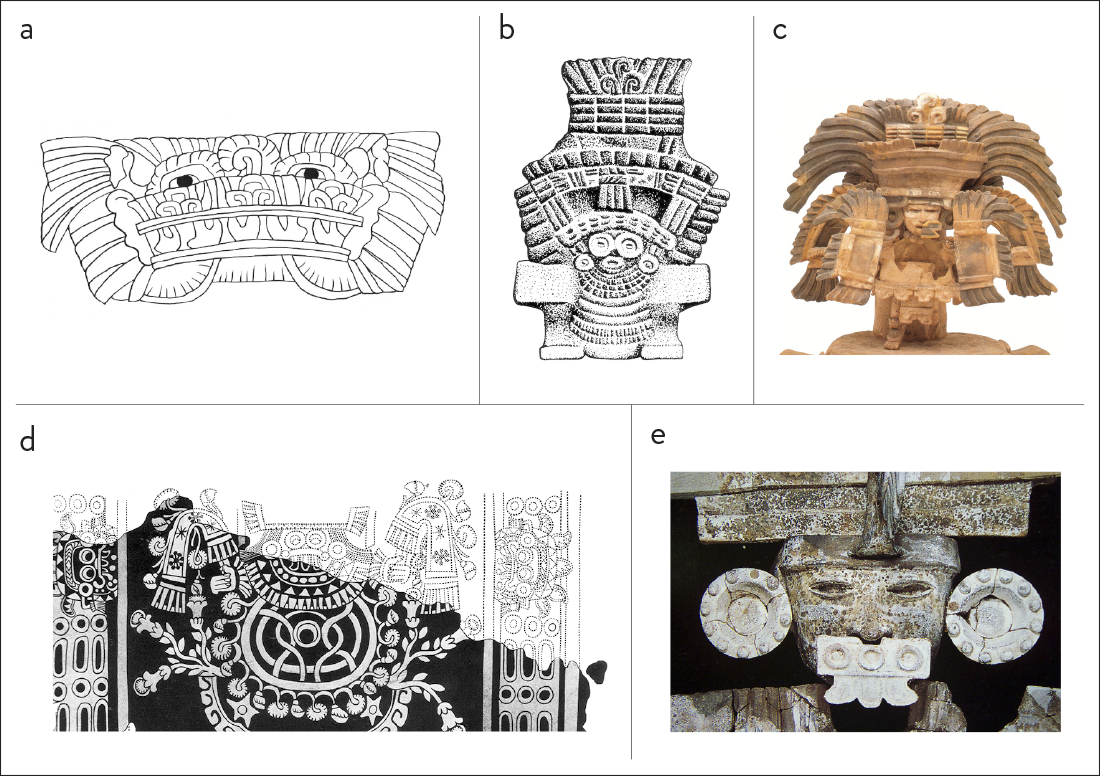
Figure 4. Butterfly Bird God iconography with smoke spirals and teeth: a) Butterfly headdress with teeth and possible smoke motifs (after Conides 2018: fig. 3.19b and pl. 16, drawing by Tania Basterrica); b) wooden bundle with flames of fire and smoke in a figurine (Winning 1977: fig. 22b); c) the Butterfly Bird God with a bundle of smoking wood in his headdress, in a censer from Oztoyahualco, Teotihuacan (Berrin & Pasztory 1993: fig. 71, detail); d) the Rain God in a Teotihuacan mural (Miller 1973: fig. 85); e) the Butterfly Bird God in a Teotihuacan censer (Berrin & Pasztory 1993: fig. 72, detail). Figura 4. Iconografía del Dios Mariposa Pájaro con espirales de humo y dientes: a) tocado de Mariposa con dientes y posibles motivos de humo (modificado de Conides 2018: fig. 3.19b y lám. 16, dibujo de Tania Basterrica); b) figurilla que tiene un atado de madera humeante y con llamas (Winning 1977: fig. 22b); c) el Dios Mariposa Pájaro con un atado de madera humeante en su tocado, en un incensario de Oztoyahualco, Teotihuacan (Berrin & Pasztory 1993: fig. 71, detalle); d) el Dios de la Lluvia en un mural de Teotihuacan (Miller 1973: fig. 85); e) el Dios Mariposa Pájaro en un incensario de Teotihuacan (Berrin & Pasztory 1993: fig. 72, detalle).
It is not the only time that smoke appears in the iconography of the Butterfly Bird God. For example, in an extraordinary censer found in the residential compound of Oztoyahualco, Teotihuacan (Manzanilla & Carreón 1991, 1993), the Butterfly Bird God is observed with a headdress that includes a bundle of wood with spirals of smoke between flames. These spirals are similar to those of the headdress that we analyze here (fig. 4c). The god of the censer exhibits his symptomatic attributes: the nose ornament in the shape of a geometric butterfly and the pendant earrings (see fig. 2a and c). It should be noted here that the fact that the god appears represented in a censer is not exceptional; on the contrary, the most frequent censers, those of the “theatre type”, center on a mask which almost certainly represents the same character. The mask shows the characteristic rectangular face paint and nose ornament in the shape of a geometric butterfly; and occasionally, we can also recognize red coloring on the god’s face, and his earring (Paulinyi 2021).
OOOOSmoke motifs sometimes appear in simple representations of the Fertile Mountain of the underworld (Paulinyi 2014: 31-33), i.e., in the symbolic landscape of the Triple Hill (see Winning 1987, vol. II: fig. 14a; Conides 2018: 144) where the Butterfly Bird God is reborn from within a broken squash (Paulinyi 2014: 29-33, fig. 7b). On one of these occasions, the Butterfly Bird God is observed rising from the underworld with open wings, beside a representation of the Triple Hill with spirals of smoke (Conides 2018: fig. 4.3c). What does the smoke that accompanies this god mean? Apparently, the rebirth of this deity and his rising from the underworld are associated with smoke. This is not surprising if we remember that he is a solar deity, and thus his rebirth is also the rebirth of fire.
OOOOIn the headdress in figure 4a, the butterfly presents a straight central tooth flanked by two pairs of curved teeth. What could be their significance be? The answer is to be found in censers in the provincial Teotihuacan style from Escuintla, Guatemala. These show the Butterfly Bird God with open wings rising from a wide-mouthed vessel representing the underworld (Hellmuth 1975: figs. 26-27, 30-31, 33; Paulinyi 2014: 38-39). Furthermore, the butterfly which forms his headdress has the teeth of the Rain God, lord of the waters and the earth. The teeth of this butterfly headdress probably also refer to the underworld and the Rain God. This proposal is supported by the fact that among the different representations of the Rain God’s teeth, there is one which is a simple version of the teeth in the headdress of the figure 4a, with one straight central tooth and just one curved tooth on each side (fig. 4d). In another censer, this time of Teotihuacan origin, the Butterfly Bird God presents a nose ornament with the same three teeth (fig. 4e), apparently replicating the teeth of the Rain God. Some images of the Water Goddess (Paulinyi 2007), a deity close to the Rain God, present a similar nose ornament, with either three or five teeth, clearly indicating that these two types of teeth are equivalent (de la Fuente 2006b [1995]: pl. 53; Kubler 1967: fig. 5).
OOOOA third vessel shows the bust in profile of a lord with the Butterfly Bird God’s face paint and a special headdress consisting of small elements and the triple hanging drop (fig. 5), just as in the case of the lord in figure 3. The headdress widens upwards and has horizontal stripes, like the headdresses of figures 4c and 3. His torso also consists of a Reptile’s Eye glyph, and he carries the feathered bundle and shield mentioned above. The image of the bust in profile is set in an aquatic landscape typical of representations of the Butterfly Bird God, consisting of broad, oblique bands of waves of water and the Triple Hill with vegetation. The same bands of water appear again on the shield that he bears. To sum up, the figure portrayed in figure 5 is a representation of another Lord of the Butterfly Bird God, quite similar to the person shown in figure 3.
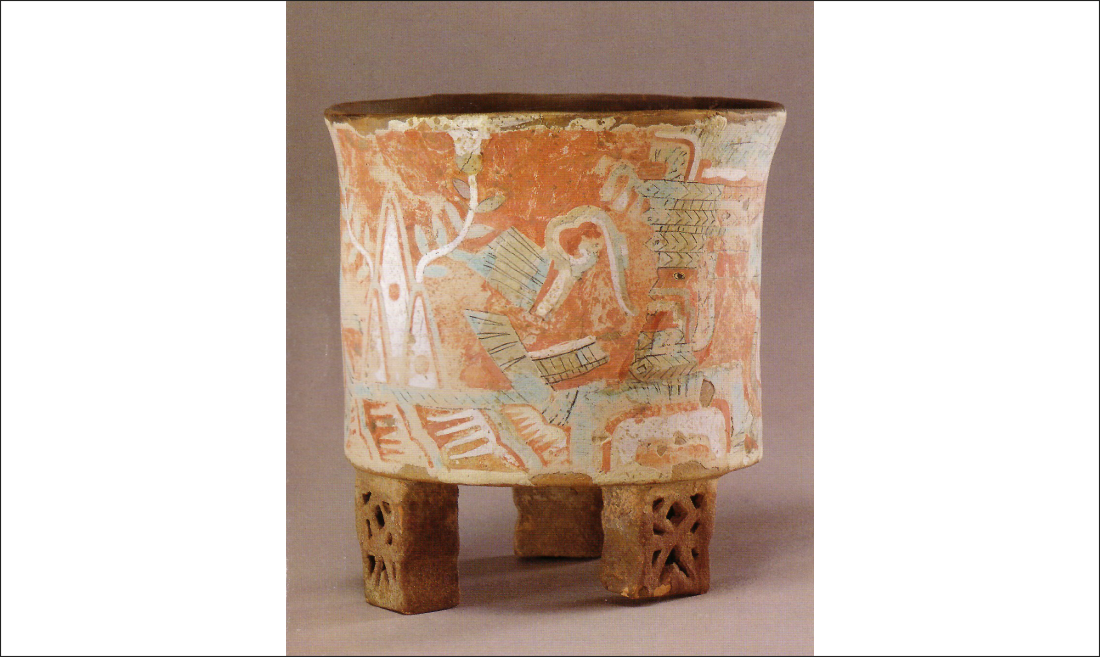
Figure 5. Lord of the Butterfly Bird God holding feathered bundle and shield (Berrin & Pasztory 1993: fig. 142). Figura 5. Señor del Dios Mariposa Pájaro sosteniendo un atado y un escudo emplumados (Berrin & Pasztory 1993: fig. 142).
Scott (2001: figs. 137e and f) identified fragments of ceramic figurines of a new type, which have in common the use of a headdress with butterfly and jaguar features. A Teotihuacan vessel shows the image of a lord in whose headdress we can see the eye and curved proboscis of a butterfly, and the big, feathered ears of a jaguar (fig. 6a). This headdress presents a merging of the butterfly, representative of the Butterfly Bird God who is a god of fire, with the jaguar, an animal of the waters and the Rain God. The lord is wearing a cape and a loin-cloth; note that a fringed hip-cloth characteristic of the Butterfly Bird God appears on either side of the loincloth (Paulinyi 2014: fig. 2; 2020). This lord is holding his ritual bag in his hand, identifying him as one presenting an offering. Before him is a flaming disc in the form of a wheel, with a starfish in its center. The flames surrounding the disc rest on the ground, above a lower strip covered with water lilies. This is a solar disc in contact with the water. It appears in another image, although without flames, as the torso of a supernatural animal consisting of butterfly and bird elements –representing the Butterfly Bird God– rising with open wings from the waters of the underworld (Winning 1987, vol. ii: fig. 9e).
OOOOThe only mural known to date that represents a Lord of the Butterfly Bird God is far from Teotihuacan in the Mayan city of Xelhá, Quintana Roo; in Structure 86 of this site, two murals have been discovered from the Early Classic period (300-600 ad) (Lombardo de Ruiz 2001: 106-109; Ruiz 2001: 289-291). Mural 1 shows mountains composed of rows of hills and a flock of birds, red macaws and parrots, circling over the hills (Navarijo 2001: fig. 8). These mountains evoke the images of the Fertile Mountain of the Butterfly Bird God in the murals of Atetelco, and during his descent to the underworld the God is dressed as a many-headed red macaw in the murals of the Palacio del Sol (Paulinyi 2014: figs. 2, 5, 10 and 11). In Mural 2 we observe a frontal view of the bust of a Lord with a Butterfly or Butterfly Jaguar Headdress, carrying an elongated rectangular object and what is likely a spear-thrower (fig. 6b).
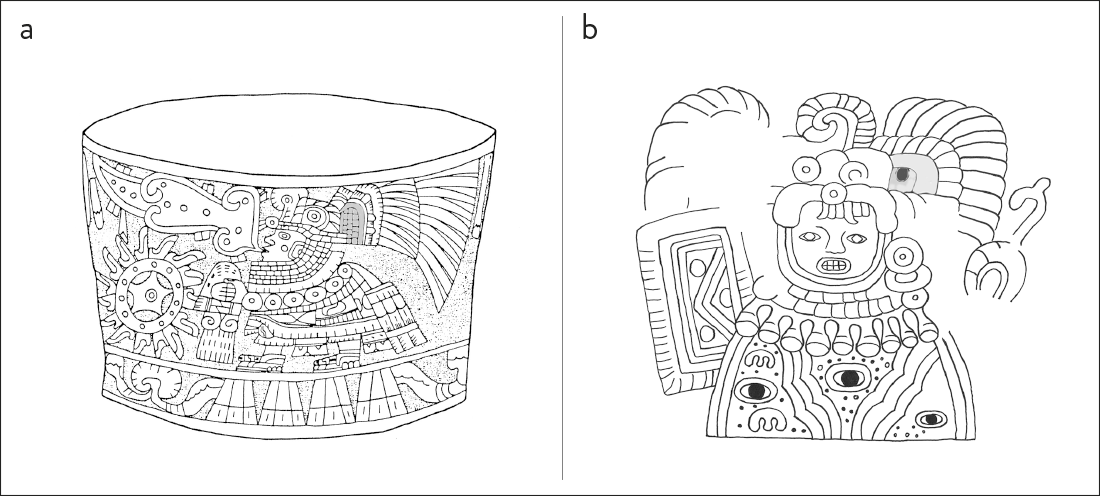
Figure 6. Lords of the Butterfly Bird God and the jaguar: a) a lord with Butterfly Jaguar Headdress, Teotihuacan (Winning 1987, vol. ii: fig. 23a). The jaguar ear is highlighted in gray; b) the lord in Mural 2 of Structure 86 at Xelhá, Quintana Roo, with Butterfly Jaguar Headdress (after Miller & Taube 1993: 49, drawing by Tania Basterrica). The butterfly eye is highlighted in gray. Figura 6. Señores del Dios Mariposa Pájaro y el jaguar: a) un señor con tocado de Mariposa Jaguar, Teotihuacan (Winning 1987, vol. ii: fig. 23a). La oreja del jaguar está resaltada con color gris; b) el señor en el Mural 2 de la Estructura 86 de Xelhá, Quintana Roo, con un tocado de Mariposa Jaguar (modificado de Miller & Taube 1993: 49, dibujo de Tania Basterrica). El ojo de la mariposa está resaltado con color gris.
It should be noted that two reproductions exist of this deteriorated mural, and they do not agree in the details of the headdress (Miller & Taube 1993: 49; Ruiz 2001: fig. 9). In both reconstructions, the headdress shows the butterfly’s proboscis, but a butterfly’s eye and jaguar’s teeth can be seen only in the first. Likewise, only this drawing reproduces the pendant earring, which is an exclusive feature of images of the Butterfly Bird God and his acolytes (see figs. 2c and 4c). To illustrate the mural, we use the first reconstruction here. When we analyze the lord`s attributes we observe a row of drops below the necklace, and bands of waves of water with triple drops and oval eyes on the torso. Eyes of this type themselves must have an aquatic connotation, since there is an image of the Rain God accompanied by similar eyes (Covarrubias 1957: fig. 22, detail). If we also consider Mural 1 with its representation of birds on hills (alluding to the place where the Butterfly Bird God is reborn), it is plausible to suppose that the lord in question may be linked in some way with the birth of the deity in the underworld. I do not share the speculations of Nielsen and Helmke (2014: 91), according to which instead of waves there is a hill, which would have been called “Eye Mountain”; in turn, this hill would have been a place of “warrior-priests”, characters similar to the figure represented in the mural. I consider that the Teotihuacan “warrior-priests” constitute a fictitious idea created by Nielsen and Helmke, whose existence has not been proven up to now.
OOOOThree of the five images of lords (figs. 4a, 5 and 6b) that we have analyzed so far not only show attributes of the Butterfly Bird God, but also appear to be related with allusions to the victorious mythical moment of his rebirth on the Fertile Mountain of the underworld (the allusions are the smoke in figure 4a, the Triple Hill in figure 5 and the hill with macaws and parrots next to the mural in figure 6b). This surely indicates that these lords are under the God’s protection, like the lord on the vessel from Kaminaljuyu shown in figure 3. I therefore propose that these five lords would have been members of the same group of the Teotihuacan elite; we will call them Lords of the Butterfly Bird God.
MORTUARY BUNDLES OF THE LORDS OF THE GOD
Among the numerous ceramic figurines from Teotihuacan, there is a recognizable group representing Lords with Butterfly Headdress dressed like the figure on the Kaminaljuyu vessel in figure 3. Some of these figurines present a characteristic conical shape (fig. 7) and belong to a group called “seated torsos” by Scott (2001: 44-46). Among the conical figurines of Teotihuacan, apart from the representations of Lords with Butterfly Headdress, other lords are observed with a wide variety of headdresses. The majority of the figurines with Butterfly Headdress are fragments; intact pieces are scarce (see Berrin & Pasztory 1993: figs. 61 and 97; Kerr: fig. 7242; Séjourné 1959: figs. 70e and 71; Séjourné 1962: fig. 41, top; Séjourné 1966a: fig. 103; Musée du quai Branly 2009: fig. 31a). The Butterfly Headdress of the conical figurines presents different variants to those of the headdress that we saw on the head of figure 3 (Scott 2001: pls. 136-137; Séjourné 1966a: figs. 124-126). The headdress may present a row of drops of water (fig. 7); we saw this motif in the Lord of Xelhá, below the necklace (fig. 6b). In one special case, the headdress has a descending bird on both sides (Conides 2018: fig. 5.7); in the iconography of this god, the descending bird refers to his descent into the underworld (Paulinyi 2014: 34-39, 40-43).
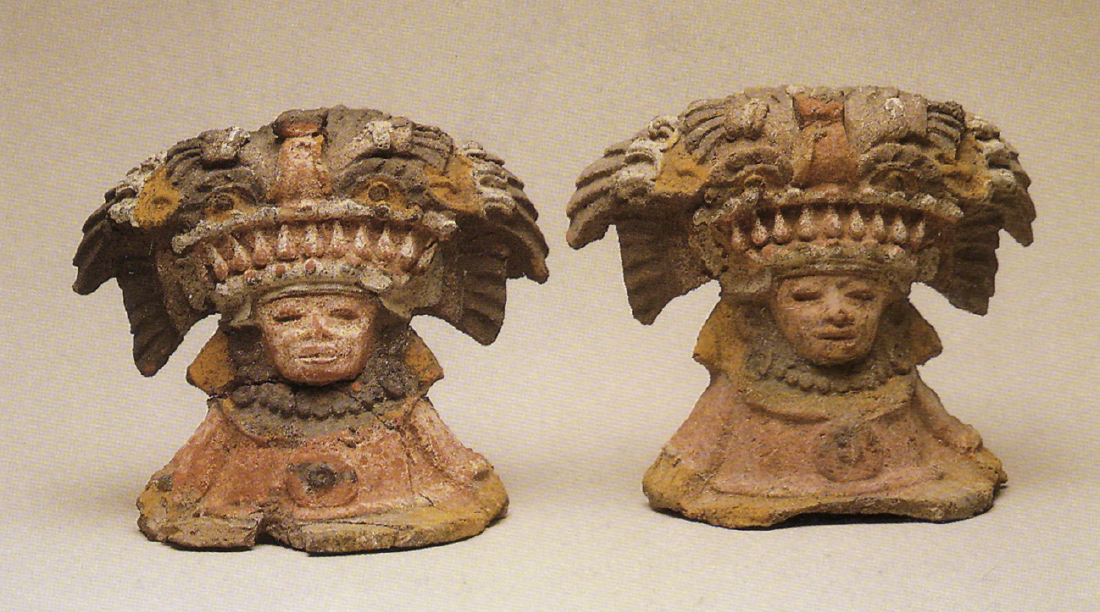
Figure 7. Figurines from Tlajinga, Teotihuacan: two figurines of probable mortuary bundles of Lords with Butterfly Headdress (Berrin & Pasztory 1993: fig. 61, detail). Figura 7. Figurillas de Tlajinga, Teotihuacan: dos figurillas de posibles bultos mortuorios de señores con tocados de Mariposa (Berrin & Pasztory 1993: fig. 61, detalle).
I must also mention at this point a conical figurine without this type of headdress, but who is nevertheless a devotee of the Butterfly Bird God because he bears several of his identifying attributes (Séjourné 1966c: fig. 108). For example, he has the pendant earring; his headdress shows a rhomboid spear-end which forms part of the iconography of the censers, the central mask of which represents the Butterfly Bird God; and he has on his breast the God’s nose ornament in the form of a geometrical butterfly.
OOOOIn my opinion, Headrick’s and Taube’s proposals that the conical figurines are representations of mortuary bundles are convincing (Headrick 1999; Taube 2002 [2000]: 306-307). It would appear that the lords of Teotihuacan shared the same headdress both in life and when converted to mortuary bundles. The most obvious example is that of the Lords with Great Tasselled Headdress; their mortuary bundle figurines (Berrin & Pasztory 1993: fig. 98; Séjourné 1966a: fig. 99; Winning 1987, vol. ii: fig. 25b) wear the same headdress as the images of the living lords themselves in the murals of Techinantitla, where they appear making offerings in procession (Millon 1988: figs. v.1-v.10). Consequently, the attributes of the conical figurines, although they generally represent mortuary bundles of lords, serve to identify groups of the elite and dignitaries in the world of the living.
OOOOHere we should mention a second group of figurines representing Lords with Butterfly Headdress, who appear on an object traditionally called a throne (fig. 8). In the general universe of figurines on thrones, the type wearing the headdress of a Lord with Butterfly Headdress is just one possible variant, since figurines exist with different types of headdress. Scott (2001: 46) raised doubts as to the validity of the term “throned figurines”, proposing instead “seated torso recessed in a frame”. When Headrick proposed that the “seated torsos” figurines represented mortuary bundles, Taube suggested that the throned figurines might have been the same, and that the “throne” was in fact a wooden frame which would have been burnt with the bundle, as occurred in representations of the Post Classic period (Taube 2002 [2000]: 306-307). In my view, some observations can be offered which appear to support the first option. In a censer from Escuintla we see a figure, probably the Butterfly Bird God himself, sitting –with his feet hanging– on a seat similar to the object under discussion for the Teotihuacan figurines (Hellmuth 1978: fig. 2). I would also mention that the sculpture of the Maize Goddess of Xochicalco, from the Epiclassic period (Nicholson 1971: fig. 22), is sitting on a seat; although at first sight it appears to be a niche, the inclined vertical frame on either side of the figure of the goddess, and the horizontal bar at the top, together with the rectangular lower part, appear to belong to the type of object associated with Teotihuacan. Two stone models of this object have been found in Teotihuacan which do not represent the wooden frames used to burn mortuary bundles in the Postclassical period but look more like seats (see Taube 2006: figs. 19 and 20 versus Musée du quai Branly 2009: fig. 28a-b). Finally, we must add that representations existed centuries later of the mortuary bundles of a ruler or high-ranking lord sitting on a throne, just as we see in the 16th century codices of the Aztec tradition (e.g., Nuttal 1903: 55; Quiñones 1995: figs. 29-31; among others).
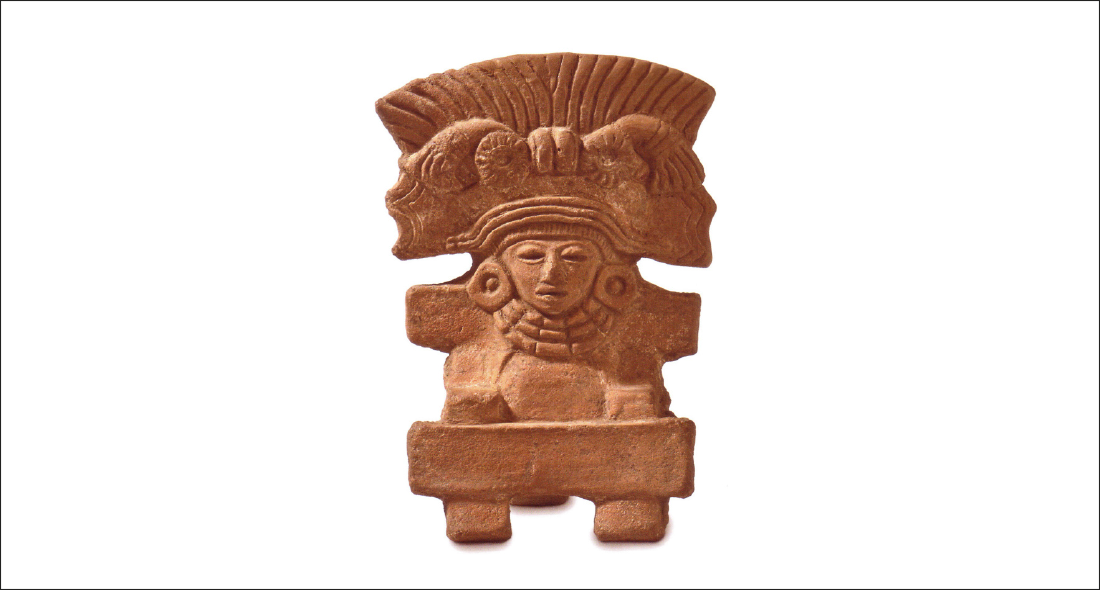
Figure 8. Figurine of possible mortuary bundle of a Lord with Butterfly Headdress placed on a throne (Musée du quai Branly 2009: fig. 31a). Figura 8. Figurilla de un posible bulto mortuorio de un señor con tocado de Mariposa sentado sobre un trono (Musée du quai Branly 2009: fig. 31a).
THE FIGURINES OF TLAJINGA
An important find was made in the residential compound 33:S3W1, Tlajinga district, Teotihuacan, of eleven figurines (ca. 500 ad), together with a “host figure” (term used for a larger ceramic figure containing figurines inside its hollow body) (Barbour 1976; Berrin & Pasztory 1993: fig. 61; Robb 2017: fig. 129; Widmer 1987: 363). The figurines can be divided into two groups: seven conical figures representing probably mortuary bundles (figs. 7, 9a-b) and four representing live people as complete, sitting figures (fig. 9c). These mortuary bundles include two Lords with Butterfly Headdress (fig. 7). They are much larger than the other figurines of mortuary bundles and are also larger than the four figurines of live people; moreover, they wear the headdress which, as mentioned above, is indicative of high rank. It should be noted that all the figurines of mortuary bundles in the Tlajinga offering are related with the iconography of the Butterfly Bird God, as is at least one of the figurines of live persons. Three of the mortuary bundles wear headdresses from the top of which emerge two bulky elements, one to the left and one to the right, one larger than the other (fig. 9a). Figurines with similar headdresses have been mentioned in different publications (Scott 2001: pls. 82g and h; 26b; Séjourné 1959: fig. 57; Musée du quai Branly 2009: fig. 199h). Furthermore, there is another figurine of a live person wearing the same type of headdress (met 1990: 95) and the pendant earring. The Butterfly Bird God and figurines of Lords with Butterfly Headdress (fig. 7) (Sugiyama 2005: fig. 75) wear the same type of earring. Finally, the figurines in figure 9a mentioned above wear a big, horizontal knot in their headdress, which also appears in the headdress of the Butterfly Bird God, as we see in the image of this god in the “Glyphs” mural of the Palace of the Sun (fig. 2c).
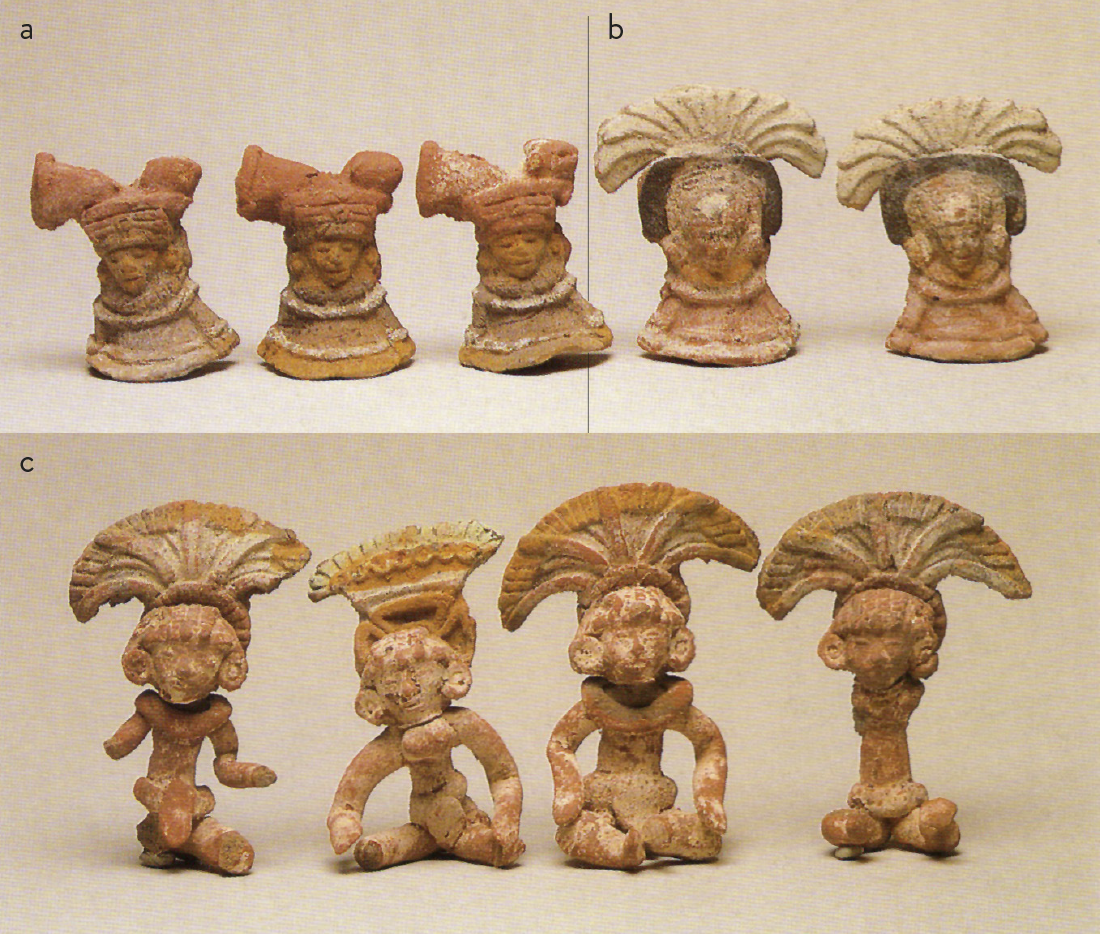
Figure 9. Three different groups of figurines from Tlajinga (a, b, c), Teotihuacan (Berrin & Pasztory 1993: fig. 61, detail). Figura 9. Tres grupos diferentes de figurillas de Tlajinga (a, b, c), Teotihuacan (Berrin & Pasztory 1993: fig. 61, detalle).
In the group of eleven figurines mentioned above, there is another case in which we can identify the same link between the figurines and the iconography of the Butterfly Bird God. I refer to two figurines who wear helmet-shaped headdresses with an element like a rounded rectangle topped by a plume of feathers (see fig. 9b). The fragment of a figurine published by Scott (2001: pl. 125a), with a helmet-shaped headdress with a similarly raised element and pendant earring typical of the God probably represents the same rank as these two figurines from Tlajinga. A possible analogy of the helmet-type with raised element is found in a censer from Teotihuacan with the iconography of the Butterfly Bird God, in which six figurines can be seen wearing a similar headdress (Hellmuth 1975: fig. 2). However, the authenticity of this censer is doubtful (Berlo 1984, part i: 39). Among the four figurines of live people in the group (fig. 9c), there is one who wears a large, four-petalled flower in his headdress, also a typical motif of the iconography of the Butterfly Bird God (e.g., in the center of the headdress in figure 2c). It is not clear whether the headdresses of the other three figurines have any connection with this iconography.
OOOOAlthough it cannot be known with any certainty who the different figurines of the Tlajinga find represent, since they were deposited as a group together with the “host figure”, the persons represented, both as mortuary bundles and live people, are probably connected in some way (see Conides 2018: 123). As the two principal figures –the mortuary bundles of figure 7– wear the Butterfly Headdress, and the common denominator in the majority of the figurines is the iconography of the Butterfly Bird God, it is reasonable to suggest that these may represent the elite group of the Butterfly Bird God, some of whose members we have already identified in vessels and a mural (figs. 3, 4a, 5, 6a and b). Considering the variety of these figurines, they probably represented individuals –living or dead– of different status within a group led by the Lords with Butterfly Headdress. It is not surprising to find an elite group with characteristics such as I propose here. My earlier identification of another group of the Teotihuacan elite that also presented an internal hierarchy –signaled by the use of different types of headdress, namely the Lords with Tasselled Headdress– supports the present proposal. Everything indicates that this group was led by the Lords with the Great Tasselled Headdress, and that it was made up of one or more lower ranks (Paulinyi 2001: 24-27).
OOOOIn view of all the above, the proposal made by Conides (2017, 2018: 115-116) that this group of figurines represents common people of Tlajinga seems unlikely. It seems to me more plausible that Tlajinga was under the control of the lords of the Butterfly Bird God, and that is why the figurines described appear. It should be noted that on the other side of the district of Tlajinga, in the residential complex 17:S3E1, a polychrome tripod vessel was discovered (fig. 10) bearing an image referring to the Butterfly Bird God. On the vessel we can identify two motifs of the iconography of said God, already known to us (fig. 3): the geometric butterfly nose ornament and a feathered object. Along with them, there is also a fanged nose ornament (mentioned in connection with the headdress in figure 4a). We have mentioned that this type of nose ornament appears on one occasion on the face of the Butterfly Bird God (fig. 4e), probably as an allusion to the aquatic underworld. Carballo (2017; 2020: fig. 3.17) interprets the elements of the image of this same vase more generally. The discovery of the vessel would support the idea that the Tlajinga district was under the control of the Lords of the Butterfly Bird God.
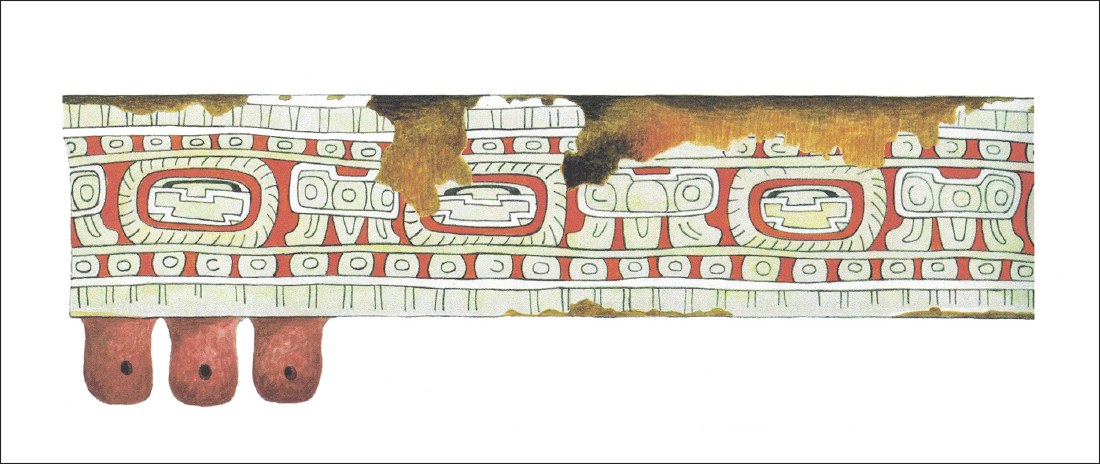
Figure 10. Rollout illustration of stucco-painted vessel from Tlajinga district, Teotihuacan (Carballo 2020: fig. 3.17). Figura 10. Ilustración extendida de una vasija pintada con estuco proveniente del distrito Tlajinga, Teotihuacan (Carballo 2020: fig. 3.17).
THE TEMPLE OF THE BUTTERFLY BIRD GOD
I conclude this work with images of temples that are associated with some figurines. One exceptional figurine representing a mortal presents the characteristic rectangular face paint, four-petalled flower and “double comb” fire symbols (fig. 11a), all attributes which frequently accompany the Butterfly Bird God (see also fig. 2a and c). This figurine is also holding a long, feathered, rectangular object in each hand. Taube (1992: 58-59) proposed that the figurine represents a warrior carrying two shields, each with a mirror in the center in the shape of a feathered disc, and a temple roof above and below this disc. On this basis he proposed the existence of a “House of Mirrors” in Teotihuacan. I must note that none of the known images of Teotihuacan shields have this long, narrow, rectangular shape. On the contrary, the shape of the shields is close to square or is circular (figs. 3 and 5) (Berrin & Pasztory 1993: figs. 126, 134 and 138; Miller 1973: figs. 200, 204 and 363; Séjourné 1966b: fig. 87; among others). I propose that these may be ritual panels, like those shown by the Butterfly Bird God himself in the censer of Oztoyahualco (fig. 4c). As the figurine does not bear any weapons, the idea that it could be a warrior must be discarded. I agree with Taube that the feathered disc is a mirror, such as I have frequently observed in Butterfly Bird God censers; I believe that it corresponds to the solar disc (see Paulinyi 1995: 87-92). Following this interpretation, the building represented in the panels held by the figurine would be the temple of the Butterfly Bird God.
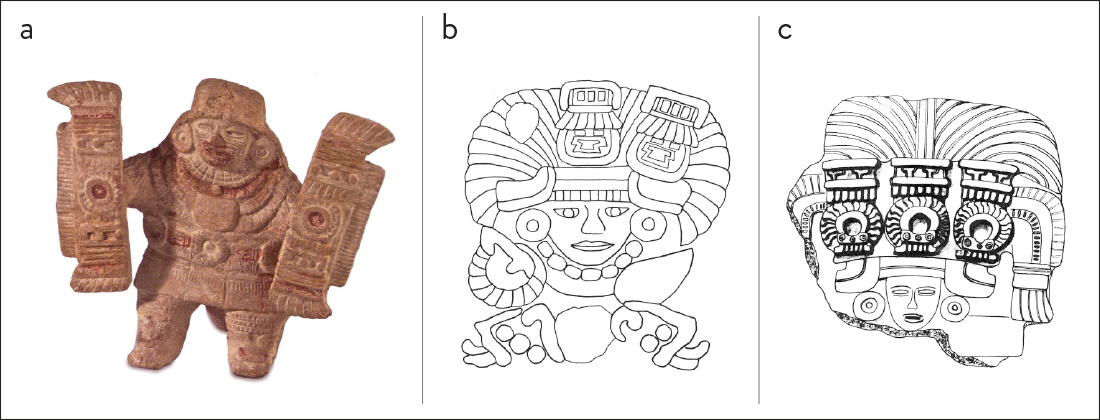
Figure 11. The temple of the Butterfly Bird God: a) character carrying elements of the iconography of the Butterfly Bird God, holding panels with representations of the temple, Teotihuacan figurine (Musée du quai Branly 2009: fig. 48); b) the Butterfly Bird God wearing images of the temple in his headdress, figurine from a Teotihuacan style “host figure” (after Taube 1992: fig. 23b, drawing by Tania Basterrica; c) figurine of lord with Butterfly Headdress wearing representations of the temple in his headdress (Winning 1947: fig. 8). Figura 11. El templo del Dios Mariposa Pájaro: a) personaje con elementos de la iconografía del Dios Mariposa Pájaro sostiene paneles con representaciones del templo, figurilla de Teotihuacan (Musée du quai Branly 2009: fig. 48); b) el Dios Mariposa Pájaro portando imágenes del tempo en su tocado, figurilla de un “host figure” de estilo teotihuacano (modificado de Taube 1992: fig. 23b, dibujo de Tania Basterrica); c) figurilla de un señor que usa un tocado de Mariposa Pájaro con representaciones del templo (Winning 1947: fig. 8).
As mentioned above, compound representations exist of the Butterfly Bird God (e.g., figs. 2b and c). We can see this in a figurine of the Butterfly Bird God with a butterfly body and an anthropomorphic head; the torso is observed to be a pyrite disc, identified by Taube (1992: 80-82) as a mirror (fig. 11b); it also wears a headdress adorned with three miniature temples. Under the roof of each appears a disc in the center of which is a geometrical butterfly, which replaces the talud-tablero platform of these small temples. I propose that the miniature temple repeated on the headdress of the figurine represents the temple of the Butterfly Bird God.
OOOOIn some cases, figurines of Lords with Butterfly Headdress present a variant of the temple analyzed here in relation to the headdress of the Butterfly Bird God figurine (fig. 11c), indicating probably that these lords are linked with the temple of their god. These lords present a new type of headdress which does away with the butterfly’s head and wings, representing only the stylized antennae hanging on either side of the headdress. It should be noted that this variant of the headdress is worn, in most cases, by the Butterfly Bird God himself; he appears with a similar headdress in the “Glyphs” mural of the Palace of the Sun in Teotihuacan (fig. 2c). The headdress of the person in fig. 11c bears three representations of a temple roof. Beneath the temple roof we see the feathered disc mentioned above, while the lower part of the disc shows a nose ornament with teeth.
OOOOAs an analogy of this model of temple, we can mention the Butterfly Headdress of a throned figurine in which we can recognize a representation of the same building (Séjourné 1959: fig. 70e). There are also fragments of figurines representing the different versions of the same temple in miniature (Sugiyama 2005: fig. 133; Scott 2001: pl. 144g; Séjourné 1966b: fig. 44; Seler 1915: pl. 34/2; Winning 1947: fig. 6). In our analysis of the Butterfly Headdress in figure 4a, I have already indicated that this nose ornament in the iconography of this god refers to the Rain God. Their appearance would appear to allude to the mythical passage of the Butterfly Bird God through the aquatic domain of the Rain God. Where in Teotihuacan was the temple of the god of these lords located? Can we identify it in the archaeological city? Linking pyramids with deities in Teotihuacan is a difficult task. There are indications that the place of worship of our god was in the enclosure of the Pyramid of the Sun –first and foremost his images in the murals of the Palace of the Sun (fig. 2c) (Paulinyi 2014: fig. 10)– but investigating this question must be the subject of another article.
Acknowledgements I would like to thank Helena Horta, who corrected and improved the Spanish of the original version of this text.
Barbour, W. 1976. The Figurines and the Figurine Chronology of Teotihuacan, Ph. D. Dissertation. University of Rochester, University Microfilms.
Berlo, J. 1984. Teotihuacan art abroad: A Study of Metropolitan Style and Provincial Transformation in Incensario Workshops. Oxford: British Archaeological Reports, International Series 199.
Berrin, K. & E. Pasztory 1993 (Eds.) Teotihuacan: Art from the City of the Gods. San Francisco: Fine Arts Museums of San Francisco.
Carballo, D. 2017. No. 132: Tripod Vessel, 400-500. In Teotihuacan: City of Water, City of Fire, M. H. Robb, ed., p. 342. San Francisco: Fine Arts Museums of San Francisco.
Carballo, D. 2020. Power, politics, and governance at Teotihuacan. In Teotihuacan, the world beyond the city, K. Hirth, D. Carballo & B. Arroyo, eds., pp. 57-96. Washington d.c.: Dumbarton Oaks.


